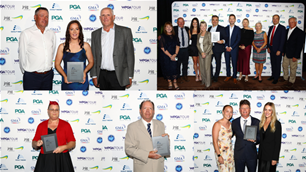What stood out for you over the past week in golf? Bryson’s winning 58? Celine Boutier going back-to-back at the Women’s Scottish Open? Justin Thomas’ run to make the Playoffs?
Or maybe you were more impressed by Charley Hoffman’s albatross Sunday at Wyndham or Davis Shore’s par-4 ace on the PGA Tour Canada?
No matter your preference, if you’re a golf spectator who likes to be dazzled by extraordinary feats, it was unquestionably a good week.
But professional golf is such a small percentage of the game and while it grabs the bulk of the headlines it is doubtful it is our most effective way to bring new people in.
Yes, there are plenty of examples of players whose first introduction was seeing Tiger, or Norman, or Karrie, or Seve, on TV and deciding they wanted to ‘have a go’.
But far more common is the golfer introduced by another golfer either through a friendly round or some kind of formalised program.
The latter option is often less successful in the longer term (for all sorts of reasons) but is one of the most effective ways to grow golf’s diversity among groups who don’t traditionally have access.
Enter Sandy Jamieson, the National Aboriginal Golf Initiative and my old home course, Mangrove Mountain Golf Club on the NSW Central Coast.
Two weeks ago, Sandy travelled from Melbourne to Mangrove with his brilliant 1Club concept to stage a ‘come and try’ day for indigenous students in conjunction with NAGI.
"The come and try day at Mangrove Mountain was a glowing example of what can be achieved with a bit of effort and co-operation and, at least for golf, could prove a very effective way forward." – Rod Morri.
(The NAGI aims to foster the sport and increase engagement and participation among indigenous communities.)
It was the bringing together of a couple of key concepts that the game could learn from beyond just the aboriginal students that were the focus of the day.
Sandy’s 1Club means a major cost factor is addressed while the involvement of community elders through NAGI gives the program credibility with the target market.
But the most important aspect is both access and the feeling of being welcome.
Local elder, NAGI committee member and Community Liaison Officer Matt Sonter (also a former Australian rugby player) summed it up best in a story on the Golf NSW website.
“We don’t need hand-outs,” he said. “We need access; we need opportunity. We need to feel welcomed.”
That is true of both indigenous and non-indigenous people when it comes to golf and if the results of the come and try day are anything to go by then what Golf NSW and NAGI are building could become a blueprint for promoting the game to the wider community as well.
There are large and complex issues surrounding race relations in Australia and in many ways the golf and non-golf worlds mirror those issues.
What’s needed in both cases is more understanding and genuine dialogue between each group.
The come and try day at Mangrove Mountain was a glowing example of what can be achieved with a bit of effort and co-operation and, at least for golf, could prove a very effective way forward.
If you or your club is interested in becoming part of the program contact Mark Ingrey at Golf NSW on mark.ingrey@golfnsw.org.au
Related Articles

Papadatos balances golf and growth as he eyes home State Open

Goggin wins NSW Senior Open after "crazy" round at Thurgoona













